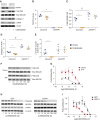Expression of RXFP1 Is Decreased in Idiopathic Pulmonary Fibrosis. Implications for Relaxin-based Therapies
- PMID: 27310652
- PMCID: PMC5148141
- DOI: 10.1164/rccm.201509-1865OC
Expression of RXFP1 Is Decreased in Idiopathic Pulmonary Fibrosis. Implications for Relaxin-based Therapies
Abstract
Rationale: Relaxin is a hormone that has been considered as a potential therapy for patients with fibrotic diseases.
Objectives: To gauge the potential efficacy of relaxin-based therapies in idiopathic pulmonary fibrosis (IPF), we studied gene expression for relaxin/insulin-like family peptide receptor 1 (RXFP1) in IPF lungs and controls.
Methods: We analyzed gene expression data obtained from the Lung Tissue Research Consortium and correlated RXFP1 gene expression data with cross-sectional clinical and demographic data. We also employed ex vivo donor and IPF lung fibroblasts to test RXFP1 expression in vitro. We tested CGEN25009, a relaxin-like peptide, in lung fibroblasts and in bleomycin injury.
Measurements and main results: We found that RXFP1 is significantly decreased in IPF. In patients with IPF, the magnitude of RXFP1 gene expression correlated directly with diffusing capacity of the lung for carbon monoxide (P < 0.0001). Significantly less RXFP1 was detected in vitro in IPF fibroblasts than in donor controls. Transforming growth factor-β decreased RXFP1 in both donor and IPF lung fibroblasts. CGEN25009 was effective at decreasing bleomycin-induced, acid-soluble collagen deposition in vivo. The relaxin-like actions of CGEN25009 were abrogated by RXFP1 silencing in vitro, and, in comparison with donor lung fibroblasts, IPF lung fibroblasts exhibited decreased sensitivity to the relaxin-like effects of CGEN25009.
Conclusions: IPF is characterized by the loss of RXFP1 expression. RXFP1 expression is directly associated with pulmonary function in patients with IPF. The relaxin-like effects of CGEN25009 in vitro are dependent on expression of RXFP1. Our data suggest that patients with IPF with the highest RXFP1 expression would be predicted to be most sensitive to relaxin-based therapies.
Keywords: RXFP1; pulmonary fibrosis; relaxin; transforming growth factor-β.
Figures




Comment in
-
Pathways to Precision Medicine in Idiopathic Pulmonary Fibrosis. Time to Relax?Am J Respir Crit Care Med. 2016 Dec 1;194(11):1315-1317. doi: 10.1164/rccm.201606-1153ED. Am J Respir Crit Care Med. 2016. PMID: 27905849 No abstract available.
-
Promise and Limitations of Relaxin-based Therapies in Chronic Fibrotic Lung Diseases.Am J Respir Crit Care Med. 2016 Dec 1;194(11):1434-1435. doi: 10.1164/rccm.201606-1256LE. Am J Respir Crit Care Med. 2016. PMID: 27905854 No abstract available.
-
Reply: Promise and Limitations of Relaxin-based Therapies in Chronic Fibrotic Lung Diseases.Am J Respir Crit Care Med. 2016 Dec 1;194(11):1435-1436. doi: 10.1164/rccm.201607-1464LE. Am J Respir Crit Care Med. 2016. PMID: 27905855 Free PMC article. No abstract available.
References
-
- Navaratnam V, Fleming KM, West J, Smith CJ, Jenkins RG, Fogarty A, Hubbard RB. The rising incidence of idiopathic pulmonary fibrosis in the U.K. Thorax. 2011;66:462–467. - PubMed
-
- Raghu G, Chen SY, Yeh WS, Maroni B, Li Q, Lee YC, Collard HR. Idiopathic pulmonary fibrosis in US Medicare beneficiaries aged 65 years and older: incidence, prevalence, and survival, 2001–11. Lancet Respir Med. 2014;2:566–572. - PubMed
-
- Yusen RD, Shearon TH, Qian Y, Kotloff R, Barr ML, Sweet S, Dyke DB, Murray S. Lung transplantation in the United States, 1999–2008. Am J Transplant. 2010;10:1047–1068. - PubMed
-
- Chihal HJ, Espey LL. Utilization of the relaxed symphysis pubis of guinea pigs for clues to the mechanism of ovulation. Endocrinology. 1973;93:1441–1445. - PubMed
Publication types
MeSH terms
Substances
Grants and funding
LinkOut - more resources
Full Text Sources
Other Literature Sources
Molecular Biology Databases

